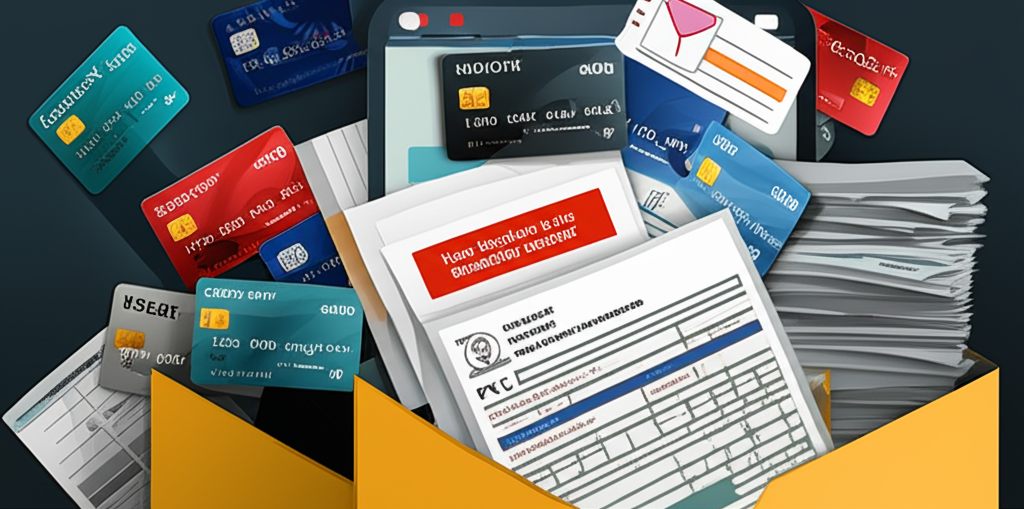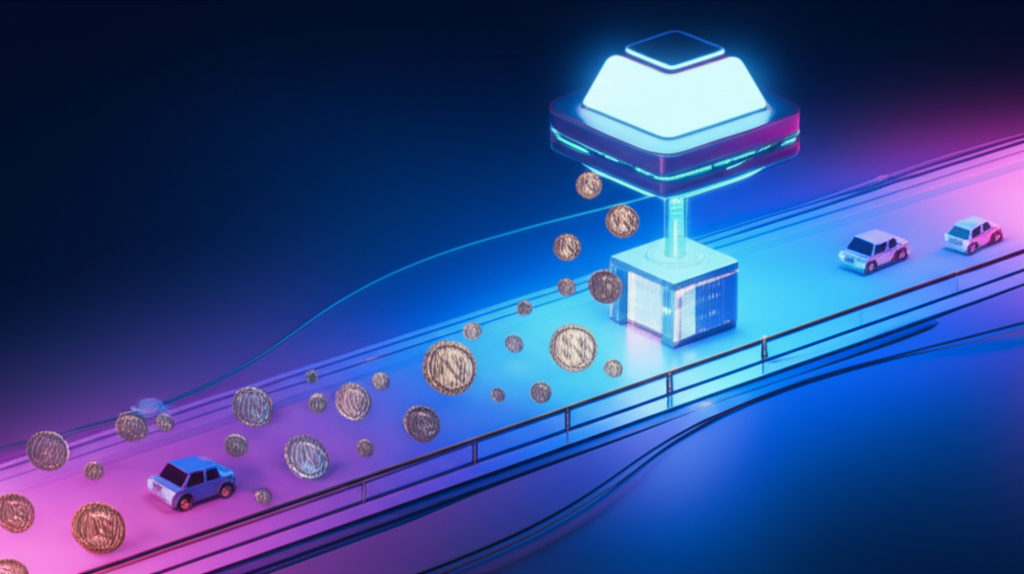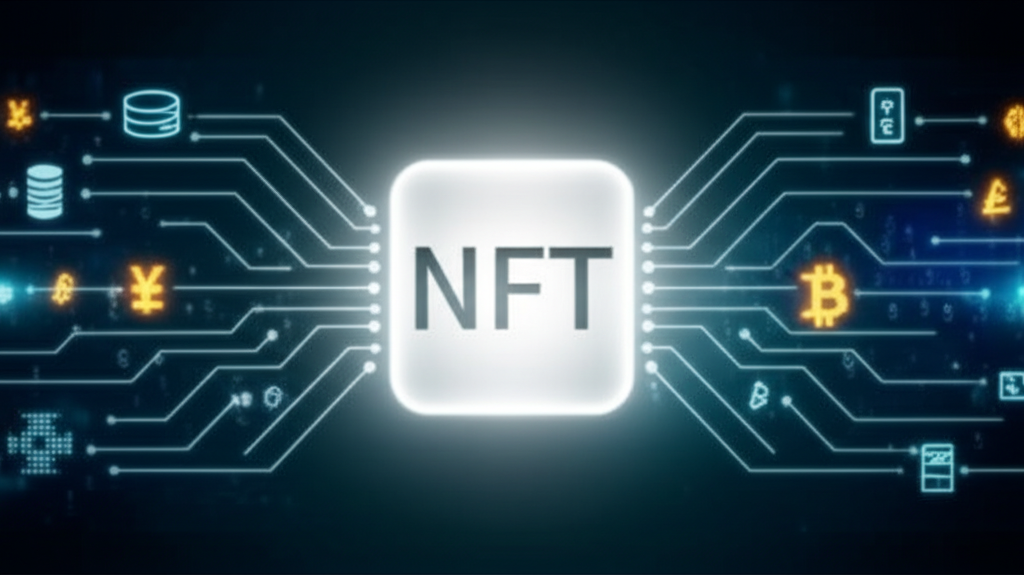Introducing our new AI-powered NFT creator
Creating NFTs has never been easier and fun!

Unlock Instant NFT Value: How x402 Changes Everything, FAST

Gregory Marcilhacy
May 7, 2025
Tired of clunky subscriptions, sky-high transaction fees, and endless sign-ups just to access digital goodies or use a specific tool once? Imagine a world where you pay tiny amounts, instantly, for exactly what you use, when you use it, no strings attached.
That world is arriving, and it's powered by a simple, elegant protocol called x402.
In this guide, you'll learn what x402 is, why it's poised to revolutionize micro-transactions, and most importantly, how it unlocks incredible new possibilities for NFTs, creators, and users alike, especially on platforms like NFT Art Generator.
Table of Contents
- Decoding the x402 Protocol: Payment Required?
- Why x402 is the Future of Digital Transactions
- The Frictionless World: What Pain Does x402 Eliminate?
- x402's Powerful Impact on the NFT Ecosystem
- Putting x402 to Work: Real-World NFT Examples
- Key Takeaways
Decoding the x402 Protocol: Payment Required?

Let's cut straight to it. What exactly is this "x402" you keep hearing whispers about? Think of it as a radically simple way for you, or more often, a piece of software you control, to instantly pay for a digital service the moment you need it.
It leverages something already baked into the internet: the HTTP 402 status code. This code has existed forever, literally meaning "Payment Required," but it was rarely used. x402 brings it to life for the web3 era.
When you (or your AI agent, or your dynamic NFT) try to access an API, download a file, or use a service that requires payment via x402, the service doesn't just block you. It responds with that HTTP 402 code, telling you exactly how much to pay and where.
You then make the specified micro-payment, typically using stablecoins on a fast, low-fee blockchain like Base or Polygon. Once the payment is confirmed (which happens in seconds), your software agent automatically retries the original request, and bam—access granted. It's a single, swift round trip: Ask, Get Price, Pay, Get Service.
It flips the traditional model. Instead of signing up, entering card details, waiting for confirmation emails, or buying credits before you know if the service even works for you, you pay on demand for the specific resource you need, right at that moment.
Stat: Traditional credit card payments often carry fees ranging from 1.5% to 3.5% or more per transaction, plus fixed per-transaction fees, making sub-$1 payments economically unviable for many online services.
This isn't about replacing major e-commerce transactions. This is about unlocking a universe of sub-cent or micro-dollar transactions that were previously impossible or too costly to process. It's tailor-made for the future of automated systems and hyper-granular access.
How it Works Under the Hood (Simply)
Imagine you're trying to get some data from an API.
- Your software sends a request (e.g.,
GET /data). - The API server responds:
HTTP/1.1 402 Payment Requiredalong with details like the amount (e.g.,0.05 USDC), the payment address, and the required blockchain. - Your software (or wallet integration) sees the 402, initiates a transaction for 0.05 USDC to the specified address on the specified chain.
- Once the transaction confirms on-chain, your software automatically retries the request (
GET /data). - This time, the server sees the confirmed payment associated with your request and responds:
HTTP/1.1 200 OKfollowed by the data you wanted.
All this happens programmatically, often within seconds, without a human needing to intervene or even see a checkout page.
- Actionable Insight: Think about APIs or digital assets you use frequently but pay for monthly. Could an x402 model offer more flexibility and cost savings by paying only for peak usage?
This protocol is designed to be open and internet-native, meaning anyone can implement it. While supported by tools like Coinbase's AgentKit for seamless machine-to-machine payments, the core specification is open source and available on x402.org. It's a standard, not a walled garden.
Why x402 is the Future of Digital Transactions

The internet is evolving. It's no longer just about humans browsing websites. It's increasingly about machines talking to machines, AI agents performing tasks, IoT devices sharing data, and software components interacting autonomously. Traditional payment systems simply weren't built for this reality.
Enter x402, purpose-built for the programmable economy.
It thrives on the characteristics that make web3 and autonomous systems powerful: composability, transparency, and efficiency. Because transactions settle on public blockchains, they are verifiable, irreversible (eliminating chargebacks!), and incredibly fast and cheap compared to legacy financial rails.
Machine-to-Machine Commerce Unchained
This is perhaps the most significant impact. Imagine an AI agent designed to find the best traits for an NFT collection. Instead of you manually subscribing to various data feeds or API plans, the agent can use x402 to pay a tiny fee each time it queries a premium database or uses a specialized analysis tool.
No pre-funded accounts to manage across dozens of services. No API keys to rotate or leak. The agent simply pays on demand, per call, for exactly the resources it consumes. It's like giving your software a self-sovereign wallet and the ability to pay its own way through the digital world.
This unlocks entirely new business models for API providers, data vendors, compute providers, and any service that can be consumed in small, discrete units.
Making Micro-Transactions Truly Micro
Want to read just one premium article? Watch one minute of a streaming video? Access one chapter of an e-book? Download a single high-resolution image?
Traditionally, you'd need a subscription, sign-up for a free trial (and remember to cancel!), or pay a minimum amount far exceeding the value of the micro-content. x402 makes genuine pay-per-use viable for even sub-cent amounts.
This isn't just theoretical. Settling in stablecoins on chains like Base means transaction costs can be fractions of a cent, clearing in seconds. This flips the economics, allowing creators and service providers to monetize granular access without burdening users with subscriptions or minimums.
- Bullet List: The x402 Advantage
- Instant Settlement: Transactions clear on-chain in seconds.
- Ultra-Low Fees: Fractions of a cent on efficient networks.
- No Chargebacks: Blockchain transactions are immutable.
- Globally Accessible: Works wherever crypto is accessible.
- Machine-Native: Designed for automated systems.
- Open Standard: Not controlled by a single entity.
This seismic shift in payment infrastructure lays the groundwork for a digital economy where value flows freely and frictionlessly between any two points, human or machine, for any amount, no matter how small.
The Frictionless World: What Pain Does x402 Eliminate?

We've all felt the pain. Signing up for yet another service, hunting for your credit card, filling out lengthy forms, agreeing to recurring charges you might forget about. Or dealing with the technical overhead of API keys and usage limits.
x402 sweeps away a massive amount of this digital detritus.
Think about the obstacles you currently face trying to access or provide digital services:
- KYC & Onboarding: Providers often need to verify your identity for compliance, a slow and intrusive process. With x402, the payment is handled by your self-custodial wallet or an agent's wallet; the service provider doesn't need to know who you are, just that the payment came from a valid source for that request.
- Credit Cards & Fees: High fees eat into margins, especially for low-value items. The risk of chargebacks requires holding funds and fighting disputes. x402 bypasses card networks entirely, using blockchain finality and minimal network fees.
- Subscriptions & Commitments: Many services force you into monthly or annual plans even if you only need them sporadically. This locks you in and often means you overpay for unused capacity. x402 enables true pay-as-you-go.
- API Key Management: Developers spend valuable time provisioning, rotating, and securing API keys. Leaked keys can lead to massive bills. With x402, access is granted per-paid-request, removing the need for persistent, vulnerable keys for simple usage.
- Geographic Restrictions: Traditional payment methods can exclude potential users based on location or banking access. As long as someone can acquire supported stablecoins, they can pay via x402.
Here's a quick comparison table to visualize the difference:
| Feature | Traditional Payments (Card/Sub) | x402 Payments (Crypto Micro) |
|---|---|---|
| Setup/Access | Account, KYC, Card Details, Subscription | Wallet (Self-Custody/Agent), Fund |
| Transaction Cost | 1.5-3.5%+ + Fixed Fee, often high min | Fractions of a cent |
| Settlement Time | Days to Weeks (incl. disputes) | Seconds |
| Chargebacks | High Risk | Practically Zero (Blockchain Finality) |
| Micro-Payments | Uneconomical | Highly Viable |
| Automation | Clunky (APIs, tokens) | Native (Designed for Agents/APIs) |
| Privacy | Links directly to Identity/Bank | Pseudonymous (Wallet Address) |
This isn't just about minor conveniences; it's about unlocking economic models that were previously impossible. It removes layers of gatekeepers and friction, making digital interactions faster, cheaper, and more aligned with the actual value exchanged.
- Actionable Insight: Evaluate the services you use. Which ones could adopt a pay-per-use model enabled by x402 to potentially save you money or offer more flexible access?
By stripping away the overhead, x402 empowers innovation at the edges. Developers can build services that require minimal, instant payments without needing complex backend infrastructure to handle billing, reconciliation, and compliance for tiny amounts. It's the payment equivalent of serverless computing – you just pay for the request.
x402's Powerful Impact on the NFT Ecosystem

Now, let's bring this revolutionary payment protocol into the world of NFTs. NFTs aren't just static JPEGs; they are becoming dynamic, interactive keys to experiences, communities, and digital utility. This utility often relies on external services, data feeds, or on-demand computations.
This is where x402 becomes a game-changer for creators and holders.
Imagine an NFT platform like NFT Art Generator. While the core generation might be a one-time or subscription cost, what about premium features? What about ongoing services tied to the NFT? x402 opens up flexible monetization and utility models previously out of reach.
Granular Access to Token-Gated Utility
Token-gating is powerful, but it's often binary: you hold the NFT, you get full access to everything (Discord, content, events). What if you could offer tiered or per-use access within that gate?
- Exclusive Content: Instead of giving holders unlimited access to a premium video library, you could use x402 to charge a micro-fee (say, $0.01) per view. This lets creators monetize usage and allows holders to pay only for what they actually consume.
- Premium Tool Features: An NFT might grant access to a set of creative tools. x402 could enable pay-per-use for computationally expensive features, like running a complex generative art filter on a new image, accessing a high-resolution download, or using an advanced trait analysis tool on a platform like NFT Art Generator.
This creates a new revenue stream for creators beyond initial sales and royalties, tied directly to the utility and engagement with the NFT's ecosystem.
Fueling Dynamic and Upgradable NFTs
Dynamic NFTs (dNFTs) change based on external data or interactions. Upgradable NFTs evolve over time. These processes often require triggering state changes or fetching new data.
- Data Feed Payments: A dNFT tracking real-world weather might need to pay a tiny fee to an API provider every hour to update its metadata. x402 is perfect for this machine-to-machine payment without needing a constant subscription or pre-paid credits tied to the NFT's owner.
- Feature Upgrades: An upgradable NFT might offer a new visual trait or ability for a small fee. x402 could facilitate this instant, one-time payment tied directly to the smart contract interaction that triggers the upgrade.
This allows dNFTs to be more responsive and feature-rich, funded by tiny, efficient payments rather than relying solely on the initial mint revenue or requiring owners to manually manage ongoing costs for automated updates.
Powering the Next Generation of NFT Platforms and Marketplaces
Platforms themselves can leverage x402 to offer more flexible services.
- Per-Use Analytics: Want detailed analytics on a specific NFT collection's traits or sales history? Instead of a monthly analytics subscription, pay a micro-fee via x402 for a specific report or data query.
- Automated Collection Management: Tools that automate tasks like checking listing statuses, sweeping floors, or triggering mints based on conditions could pay tiny x402 fees for each action performed by an agent on your behalf.
- Trait Marketplace Access: Accessing deep data within a trait marketplace, perhaps querying rarity scores based on specific combinations or getting historical sales data for individual traits, could be monetized via x402 per query, providing granular value.
- API Access for Builders: Platforms like NFT Art Generator could offer API access for developers building on top of their infrastructure, monetizing API calls via x402, making it easy for anyone to integrate without lengthy contracts.
This granular monetization model can reduce barriers to entry for users (no large subscriptions) and unlock new revenue streams for platform builders.
Putting x402 to Work: Real-World NFT Examples

Let's get concrete. How might you actually encounter or implement x402 in the wild as the technology matures?
Scenario 1: The Premium Content Vault
A popular NFT collection grants holders access to an exclusive content platform. Instead of making all content free, creators label certain high-production value videos or in-depth reports as "Premium x402 Access."
When a holder clicks on premium content, their wallet or a browser extension (like Coinbase's built-in support) is prompted to approve a micro-payment of, say, $0.02 USDC via x402. They approve, the payment settles instantly on Base, and the video loads immediately. The creator earns per-view revenue, and the holder pays only for the specific content they watch.
Scenario 2: The Dynamic Weather NFT
An artist creates beautiful landscape NFTs that depict the current weather conditions of a famous location. This NFT needs to query a weather API hourly.
Instead of the artist paying a large monthly API bill, the NFT's smart contract or an associated service uses x402 to pay the weather API provider $0.005 per query. The cost is negligible for individual updates but creates a sustainable revenue stream for the API provider, funded by tiny, automated payments.
Scenario 3: Enhancing NFT Generation on Platforms
A user on NFT Art Generator has a standard generation plan. However, they want to use a cutting-edge, computationally intensive AI feature to generate one ultra-rare trait variation for a specific NFT in their collection.
This premium feature is enabled via x402. The user is prompted to pay $0.50 for this specific generation run using x402. They approve the payment via their wallet, the generation process kicks off instantly, and they get their unique trait variation without needing to upgrade their entire subscription plan.
| x402 NFT Use Case | Value Proposition (Creator) | Value Proposition (User) |
|---|---|---|
| Premium Content Access | New per-usage revenue stream, measure engagement | Pay only for consumed content, flexible access |
| Dynamic Data Updates | Sustainable funding for dNFT data feeds | dNFTs stay current without owner's manual effort |
| Per-Feature Tool Access | Monetize niche/expensive tools granularly | Access advanced tools without full subscription |
| Automated Agent Actions | Enable third-party service integration | Delegate tasks to agents, pay per action |
| Trait Data / Analytics | Monetize deep data access | Get specific insights without full plan |
These examples show how x402 moves beyond simple asset ownership to enable a world where NFTs are keys to a suite of services, consumed and paid for instantly, efficiently, and frictionlessly at the point of interaction. It builds a more dynamic, economically active layer around the static NFT asset.
It's a future where your NFT wallet doesn't just hold assets, but acts as your payment passport for instant access to digital value, powered by protocols like x402 and built on platforms that embrace this innovation, like NFT Art Generator.
Key Takeaways
- x402 is an open protocol using HTTP 402 to enable instant, per-request crypto micro-payments for digital services.
- It's ideal for machine-to-machine commerce, AI agents, and making sub-cent micro-transactions economically viable.
- x402 eliminates the pain of KYC, credit cards, subscriptions, high fees, and API key management for granular digital access.
- For NFTs, x402 unlocks new potential by enabling granular, per-use access to token-gated content, funding dynamic NFT updates, and powering flexible monetization models for platforms and tools.
- Platforms like NFT Art Generator can potentially integrate x402 to offer pay-per-feature access or monetize API endpoints for builders.
Ready to explore the future of NFT utility and frictionless digital payments? Dive into platforms building this future.
Browse other posts